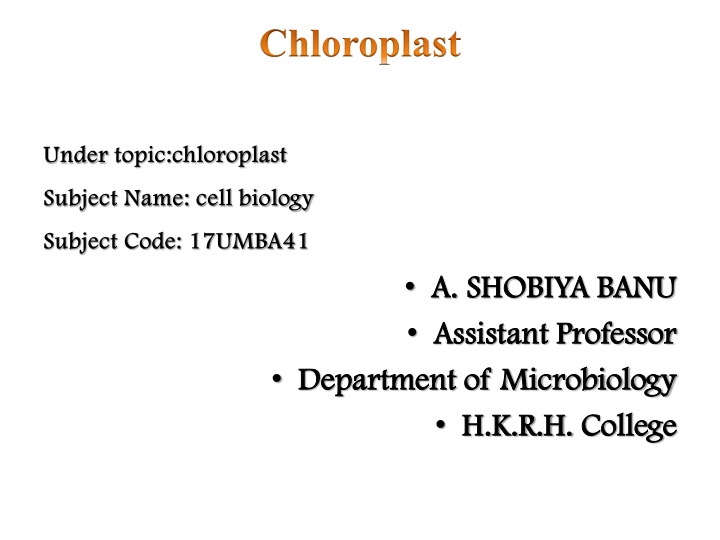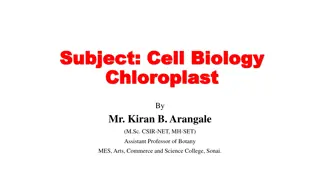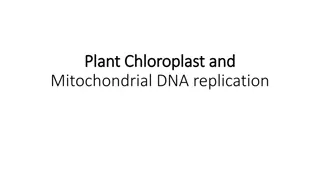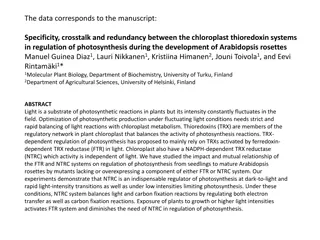Chloroplast
Chloroplasts are vital organelles in plant cells, facilitating photosynthesis and oxygen production. They vary in shape and size, composed of outer and inner membranes, thylakoid system, and stroma. Understanding their structure and function is key to comprehending plant biology.
Download Presentation

Please find below an Image/Link to download the presentation.
The content on the website is provided AS IS for your information and personal use only. It may not be sold, licensed, or shared on other websites without obtaining consent from the author.If you encounter any issues during the download, it is possible that the publisher has removed the file from their server.
You are allowed to download the files provided on this website for personal or commercial use, subject to the condition that they are used lawfully. All files are the property of their respective owners.
The content on the website is provided AS IS for your information and personal use only. It may not be sold, licensed, or shared on other websites without obtaining consent from the author.
E N D
Presentation Transcript
Chloroplast Under Under topic:chloroplast topic:chloroplast Subject Name: cell biology Subject Name: cell biology Subject Code: 17UMBA41 Subject Code: 17UMBA41 A. SHOBIYA BANU A. SHOBIYA BANU Assistant Professor Assistant Professor Department of Microbiology Department of Microbiology H.K.R.H. H.K.R.H. College College
INTRODUCTION Chloroplasts are organelles present in plant cells and some eukaryotic organisms. Chloroplasts are the most important plastids found in plant cells. The chloroplasts take part in the process of photosynthesis. Animal cells do not have chloroplasts. All green plant take part in the process of photosynthesis which converts energy into sugars and the byproduct of the process is oxygen that all animals breathe.
EXPLANATION Chloroplasts found in higher plants are generally biconvex or planoconvex shaped. In different plants chloroplasts have different shapes, they vary from spheroid, filamentous saucer-shaped, discoid or ovoid shaped. SIZE Chloroplast also varies from species to species The average size of chloroplast is 4-6 in diameter and 1-3 in thickness.
THREE MEMBRANE Outer membrane Inner membrane Thylakoid system Outer membrane - It is a semi-porous membrane and is permeable to small molecules and ions. The outer membrane is not permeable to larger proteins. Intermembrane - Thin intermembrane space about 10-20 nanometers and it is present between the outer and the inner membrane of the chloroplast.
Inner membrane The inner membrane of the chloroplast forms a border to the stroma. In addition of regulation activity, the fatty acids, lipids and carotenoids are synthesized in the inner chloroplast membrane. Stroma Stroma is a alkaline, protein rich and is present within the inner membrane of the chloroplast. The space outside the thylakoid space is called the stroma. The chloroplast DNA chloroplast ribosome and the thylakoid system, starch granules and many proteins are found floating around the stroma.
Thylakoid System The thylakoid system is suspended in the stroma. The thylakoids are arranged in stacks known as grana. Each granum contains around 10-20 thylakoids. Important protein complexes which carry out light reaction of photosynthesis are embedded in the membranes of the thylakoids. Two Types granal thylakoids stromal thylakoids
Granal thylakoids Arranged in the grana are pancake shaped circular discs, which are about 300-600 nanometers in diameter. The stromal thylakoids are in contact with the stroma and are in the form of helicoid sheets. Stromal thylakoids The photosystem I and ATP synthase protein complexes are present in the stroma. These protein complexes acts as spacers between the sheets of stromal thylakoids.
Light reactions take place on the membranes of the thylakoids. Chloroplasts, like the mitochondria use the potential energy of the H+ ions or the hydrogen ion to generate energy in the form of ATP. The dark reactions also known as the Calvin cycle take place in the stroma of chloroplast.





